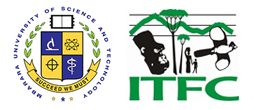This study was undertaken under the Greater Virunga Transboundary Collaboration (GVTC) involving three partner states of Democratic Republic of Congo (DRC), Rwanda and Uganda. The collaborative transboundary framework of programs, plans and activities is aimed at conserving the network of Protected Areas (PAs) in the Greater Virunga Landscape (GVL). The GVL covers areas and communities around the PAs of Volcanoes National Park in Rwanda; Virunga National Park in DRC and five national parks (NP) in Uganda: Mgahinga Gorilla NP, Bwindi Impenetrable NP, Queen Elizabeth NP, Rwenzori Mountains NP, and Semliki NP. The landscape is unique and is a hot spot for biodiversity as it contains rare and charismatic species such as the Mountain Gorillas (Gorilla beringei beringei), chimpanzees and African elephants.
Climate change is perceived to be a major threat with long-term effects on the ecosystems and behaviour of wildlife. Climate Change is believed to exercise compounding effects, exacerbating the impacts of other threats to the biodiversity and ecosystem services within the GVL. In cases where climate change has resulted in habitat change, it is not clear what will happen to the plants and animals that survived in such sites.
Hence the GVTC Climate Change Strategy has the overall objective of strengthening landscape-wide resilience to climate change and ensuring climate compatible conservation measures for sustainable livelihood in the GVL. Implementing this strategy, required a baseline of the current effects of climate change on species, ecosystems, and ecological processes in order to understand how Ecosystem Services will be affected by future changes. It is also important to undertake forecast climatic conditions at high spatial resolution across the GVL to serve conservation planning needs. These forecasts need to be robust, taking account of exposure, adaptive capacity and sensitivity components. There is also a need to identify the tipping points of species, ecosystems, and ecological processes to stressors associated with climate change so that we can avoid crossing critical thresholds, beyond which it may be difficult and costly to restore or find substitutes for important Ecosystem Services. Similarly, there is a need to improve understanding of how current threatening processes such as invasive species, mining, land use, diseases of humans, livestock and wildlife will change under different climate change scenarios.
The overall purpose of the current consultancy, therefore, was to (i) strengthen the knowledge base in order to enhance common understanding of climate change risks and its impacts on biodiversity, ecosystems and associated services and the socio-economic system of the GVL; and (ii) propose appropriate actions for managing and mitigating negative changes in biodiversity and ecosystem services in the GVL. The current study specifically focussed on the following tasks:
- Identifying the drivers of Climate Change in the in the GVL
- Describing how species, ecosystems, and ecological processes within the GVL are currently affected by climate change in order to understand how ecosystem services will be affected by future changes
- Undertaking a forecast of climatic conditions sufficiently robust and that take account of exposure, adaptive capacity and sensitivity components
- Describing how current threatening processes such as alien invasive species, mining, land use, diseases of human disease, livestock and wildlife will change under different climate change forecasts
- Proposing appropriate actions for managing and mitigating negative changes in biodiversity and ecosystem services in the GVL
The methods for this study included a review of literature to establish the background knowledge about drivers and impacts of climate change on biodiversity and ecosystem services in the GVL. The WOCAT-LADA-DESIRE mapping tool was used to aid in identifying and assessing the drivers and impacts of climate change on biodiversity and ecosystem services. This was integrated with key informant interviews. Land Use Land Cover change and land degradation hotspots assessment was implemented to aid in identifying and assessing the drivers and impacts of climate change on biodiversity and ecosystem services climate modelling was carried out to generate projections for the GVL.
Drivers of Climate Change in the in the GVL: The study, as expected, shows that climate change is occurring in the GVL and is mainly driven by anthropogenic factors, especially increased land use intensity. This is driven by increased population growth and its associated demand for land for agriculture and settlement. In addition, there is unsustainable utilisation of natural resources.
Current effects of climate change on species, ecosystems, and ecological processes and potential future effects on ecosystem services: Climate change will negatively affect species, ecosystems and ecological processes in the GVL if appropriate mitigation and adaptation actions are not implemented.
Forecast of climatic conditions taking account of exposure, adaptive capacity and sensitivity: The GVL still provides a wide range of ecosystem services that vary spatially. The climate forecast for the GVL in the near future (2020-2039) under both RCP 4.5 and 8.5 generally shows an increase in both rainfall and temperature.
Changes in threatening processes under different climate change forecasts: The projected climatic conditions will thus affect several ecosystem services and processes in the GVL. These effects are more likely to occur in DRC and Uganda and under RCP 8.5 as compared to RCP 4.5.
The following actions are proposed for managing and mitigating negative changes in biodiversity and ecosystem services
- Scaling up Sustainable Land Management (SLM)
- Managing human population growth
- Enhancing restoration of degraded ecosystems
- Sustaining promising/successful interventions
- Management Planning to emphasise climate change issues:
- Planning around adaptation frameworks
- Enhancing Research and Ecological Monitoring
